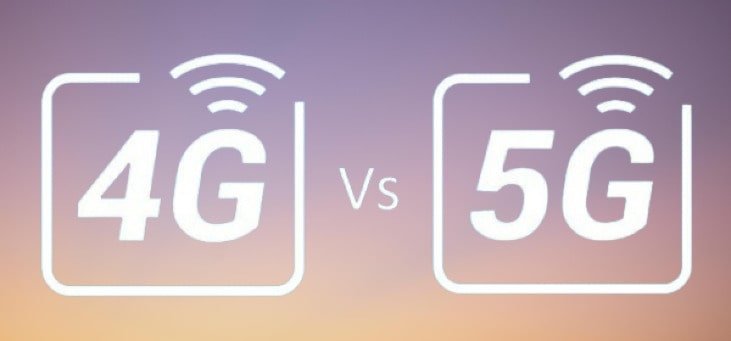5G vs 4G comparion: What are differences between them?

When 4G was introduced in 2009, a ton of new options for mobile phones became possible. Fifth-generation wireless technology, or 5G, is now available and promises even improved performance for cellular users. Mobile phone speeds reach new heights thanks to 5G networks, which also enable wireless residential Wi-Fi.
Read on for an explanation of the differences between 5G vs 4G networks, speeds, and more. We‘ve been closely monitoring 5G’s development over the past three years.
Contents
Which is faster, 5G vs 4G?
In many circumstances, 5G is far quicker than 4G, and its speed is accelerating every month.
In small towns and rural areas, where 5G networks are sparse, 4G still reigns supreme (or nonexistent). But 5G is starting to take off in many American locations, and speeds can range from being only marginally faster than 4G LTE to being exponentially faster.
Because 5G networks employ higher-frequency radio channels to relay signals, you can get quicker speeds. These bands have greater capacity to transmit data across the airways because some of them were previously used for very little commercial use.
How do 5G vs 4G differ from one another?
Because 5G is the most recent generation of wireless technology, it differs from 4G. On average, it’s more than twice as fast as 4G and in some urban areas, it may reach rates of up to 1,000 Mbps. Users of 5G phones and hotspots report decreased network traffic congestion and lower latency levels. Additionally, they are utilized for newly developed services like 5G home internet, which were not extensively accessible on 4G networks.
Timeline of using the five “G”s
Because 5G is the most recent generation of wireless technology, it differs from 4G. Mostly, it enhances cell phone users’ speeds and performance. However, it also increases the adaptability of cellular carriers, enabling them to (perhaps) use their networks in the workplace, the home, the car, hospitals, and industries.
The most recent advancement in wireless technology is 5G. The first cell phone network was introduced in 1979 by the Japanese business Nippon Telegraph and Telephone, and a 5G network is unquestionably an universe apart from that.
What are differences between 5G vs 4G technology?
The fourth wireless technology generation is known as 4G. It uses radio towers to provide wireless internet and phone service to mobile devices. The basic operation of 5G is the same, however it uses new technologies and higher radio frequencies.
In order to give faster speeds with a quicker reaction time, 5G networks also employ more base stations. Some 5G service providers intend to decentralize their networks in the future (using a method known as “edge computing”) to make them more adaptive and versatile for various uses.
Cellular providers are striving to create “standalone” 5G networks based on a few fundamental ideas, even though 5G networks now rely mostly on 4G and 4G LTE towers.
- The millimeter wave – Radio waves with an incredibly high frequency that can send gigabit-plus speeds to your mobile device.
- Beamforming – High-precision antenna arrays with the ability to target specific devices with wireless transmissions.
- A lot of MIMO – 5G transmitters that have been reinforced to carry wireless data to devices at a much greater rate.
It should come as no surprise that all of this will take time to accumulate and will also be very expensive for providers.
What variations of 5G are there?
There are three main sorts of 5G networks, which correspond to the range and speed that each type can offer your phone. Here is a brief explanation:
Low-band 5G
Low-band 5G provides somewhat better speeds—around 50-60 Mbps—over long distances by using some of the same radio frequencies as 4G. It will function best in rural areas where people are more dispersed and service can be provided by a few cellular towers.
Mid-band 5G
Higher-frequency radio bands than 4G are included in mid-band 5G. With transmitters capable of reaching phones within several kilometers, mid-band 5G has a lesser range. But compared to 4G, it can give much quicker rates. The mid-band portion of T-5G Mobile’s network dominates.
C-band 5G
The “sweet spot” in the radio spectrum that enables cellular providers to give their 5G networks a wide coverage while enabling fast speeds is known as the C-band (3.7-4.2 GHz). Through the end of 2022, Verizon and AT&T will have installed C-band frequencies across their 5G networks, enabling phones and hotspots to reach speeds of up to 500 Mbps.
Millimeter-wave 5G
The most advanced 5G version is this one. It uses so-called “millimeter-wave” radio bands, which get their name from how small and high-frequency they are (25–39 GHz).
A millimeter wave transmitter attached to a nearby utility box or light post may transfer data at gigabit-plus speeds across a very short distance, typically just what is in its line of sight. So it functions best within buildings and in densely populated places.
5G vs 4G latency
The latency of 5G is lower than that of 4G. This reduces lag and poor video quality, making 5G phones far more responsive when it comes to activities like video calls and gaming.
The small lag that occurs when a signal is sent from a device to a network server and vice versa is known as latency (also known as ping rate). Due to the physical separation between your device and the server providing it with an internet connection, some minimal delay is unavoidable in all internet connections.
However, the lesser the latency, the better, particularly if you use the internet for activities that demand nearly instantaneous connectivity. Activities like playing a fast-paced online game or video chatting become much smoother and easier to do thanks to 4G’s lower latency rates.
It is the aim of wireless technology specialists that 5G will eventually attain latency rates as low as 1 ms. That would be a fantastic accomplishment that would increase 5G’s capacity to serve sophisticated applications like systems for factories and driverless vehicles. That 1ms goal, though, is still a long way off.
Conclusion
Read the 5G vs 4G comparison above article, it is sure that with 5G, things should advance even further. Since 5G is still a young technology, it doesn’t currently have the same reach as 4G, but analysts are optimistic. Ultra-fast 5G networks may eventually help create the “internet of everything,” where decentralized online networks are fundamental to work, healthcare, industry, transportation, and daily living.
Please read: http://tech.amthucdatviet.com/top-10-telecom-companies-in-us/
Conclusion: So above is the 5G vs 4G comparion: What are differences between them? article. Hopefully with this article you can help you in life, always follow and read our good articles on the website: Tech.amthucdatviet.com







